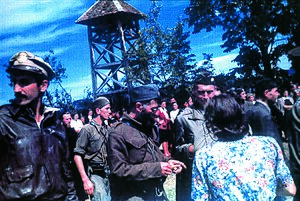
Back Операция Фал Bulgarian Operação Halyard Portuguese Operacija Vazdušni most Serbo-Croatian Операција Ваздушни мост Serbian
| Halyard Mission | |
|---|---|
| Part of World War II in Yugoslavia | |
 Joint US/Chetnik military ceremony in Pranjani September 6, 1944: Capt. Nick Lalich (OSS), Gen. Dragoljub Mihailović (Yugoslav Army in the Homeland), and Col. Robert H. McDowell (OSS). | |
| Type | Airlift/Special operation |
| Location | 44°02′09″N 20°10′41″E / 44.03583°N 20.17806°E |
| Commanded by | |
| Objective | Rescue of U.S airmen |
| Date | 2 August – 27 December 1944 |
| Executed by | |
| Outcome | Mission success |
Operation Halyard (or Halyard Mission), known in Serbian as Operation Air Bridge (Serbian: Операција Ваздушни мост, romanized: Operacija Vazdušni most),[1] was an Allied airlift operation behind Axis lines during World War II. In July 1944, the Office of Strategic Services (OSS) drew up plans to send a team to the Chetniks force led by General Draža Mihailović in the German-occupied Territory of the Military Commander in Serbia for the purpose of evacuating Allied airmen shot down over that area.[2] This team, known as the Halyard team, was commanded by Lieutenant George Musulin, along with Master Sergeant Michael Rajacich, and Specialist Arthur Jibilian, the radio operator. The team was detailed to the United States Fifteenth Air Force and designated as the 1st Air Crew Rescue Unit.[3] It was the largest rescue operation of American airmen in history.[4]
According to historian Professor Jozo Tomasevich, a report submitted to the OSS showed that 417[5] Allied airmen who had been downed over occupied Yugoslavia were rescued by Mihailović's Chetniks,[6] and airlifted out by the Fifteenth Air Force.[2] According to Lieutenant Commander Richard M. Kelly (OSS), a grand total of 432 U.S. and 80 Allied personnel were airlifted during the Halyard Mission.[7] According to Robert Donia, allied air operations over Partisan territory in Yugoslavia were strategically significant and extensive in scope. Evaders’ forms show that airmen landed on much of Yugoslavia from eastern Serbia to Slovenia and even on Bulgaria. Evacuees most frequently mentioned airstrips at Tičevo, Sanski Most and on the Croatian coastal island of Vis. Of the 2,364 flyers rescued from Yugoslavia, about 2,000 were extracted from Partisan-controlled territory and 350 from Chetnik-controlled territory.[8]
- ^ Miodrag D. Pešić (2004). Misija Haljard: spasavanje savezničkih pilota od strane četnika Draže Mihailovića u Drugom svetskom ratu. Pogledi. ISBN 9788682235408.
- ^ a b Leary (1995), p. 30
- ^ Ford (1992), p. 100
- ^ "US commemorates Serbian support during WWII". U.S. Air Forces in Europe - Air Forces Africa. November 21, 2016.
- ^ Tomasevich (1975), p. 378
- ^ Leary (1995), p. 32
- ^ Kelly (1946), p. 62
- ^ Robert J. Donia, The Forgotten Thousands: The Historiography of World War II Rescues of Allied Airmen in Yugoslavia. Akademija Nauka i Umjetnosti Bosne i Hercegovine, 2020, p. 300-303
